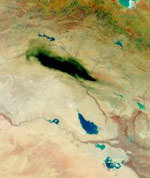
Image credit: ESA
The European Space Agency’s Envisat environmental satellite captured this image of a burning oil pipeline in northern Iraq. The immense black cloud stretched over thousands of square kilometres in the valley between the Tigris and Euphrates rivers. The pipeline transfers oil from Kirkuk to Baija, and another photo from Envisat shows how the area looked before the fire.
A burning oil pipeline in northern Iraq produced an immense cloud of black smoke that stretched across thousands of square kilometres, in this image acquired by Envisat?s Medium Resolution Imaging Spectrometer.
The smoke cloud is visible in the centre of this image of the alluvial plain occupied by the valley of the river Tigris (flowing from the top centre of the image) and the Euphrates (flowing from the top left corner).
The Medium Resolution Imaging Spectrometer (MERIS) on ESA?s Envisat environmental satellite acquired the image on 30 August, the same day as the media reported a fire affecting a segment of oil pipeline near the town of Hawija.
The pipeline transports crude oil from the oil-rich city of Kirkuk ? seen here in grey, on the Tigris River – to Baija, where the country?s largest oil refinery is located. For comparison the second MERIS image shows the same area three days earlier, before the pipeline had been damaged.
The dense cloud of smoke has an extent comparable to the Iranian lake Urmia (which has an area of 4700 square kilometres), seen in turquoise colour towards the top right of the image. Authorities stated it took two days to bring the fire under control.
These three-band MERIS images have a resolution of 1200 metres and were processed by Hamburg-based Brockmann Consult.
Original Source: ESA News Release
